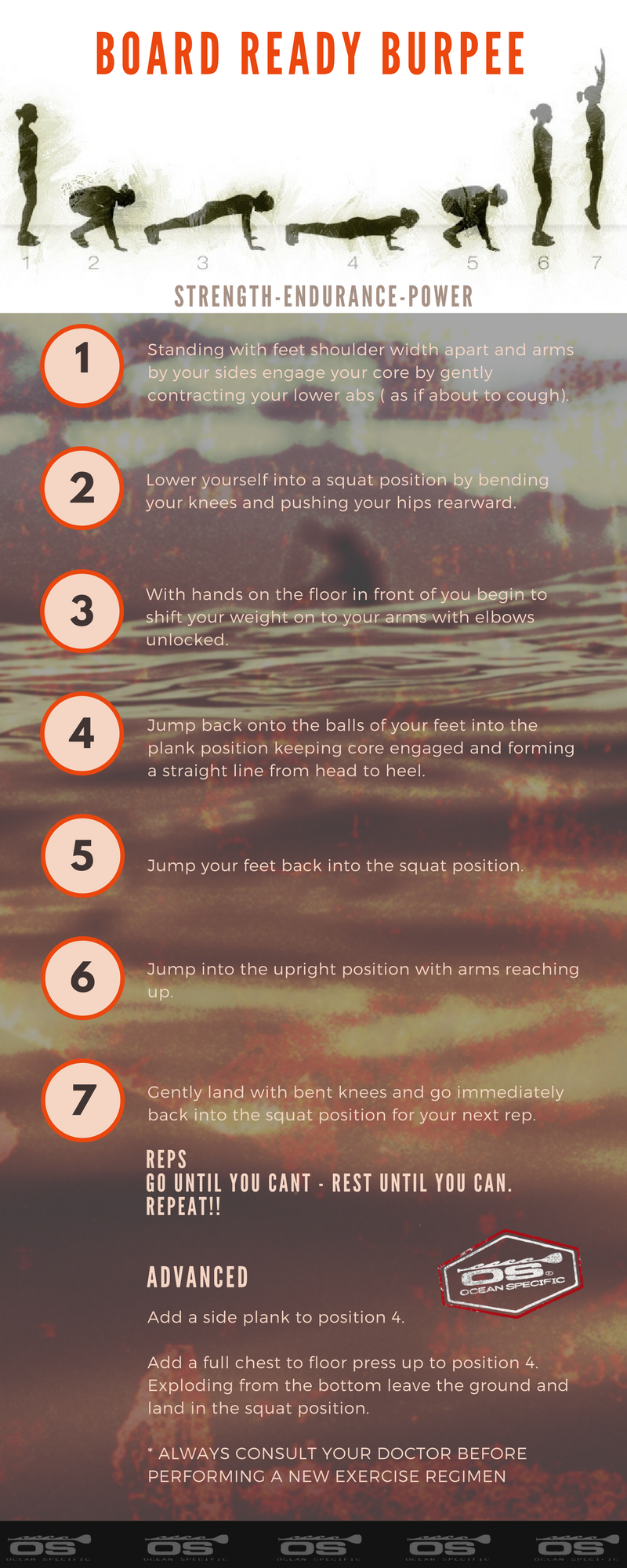Board Ready Burpee



Every race starts with a finely tuned engine.
An increase in your VO2max through aerobic activity will greatly increase the amount of oxygen your body can not only hold in your lungs but shuttle to where it's needed efficiently between breaths. This should form the bulk of your program. To increase your aerobic threshold any activity should put your heart rate at between 75-85% of your max heart rate for 20-60 min.
Don't do static stretching before a race. It's not the same as warming up and could do damage. Imagine your tendons as cold toffee ... it doesn't stretch well. Warm toffee however can stretch without breaking. Dynamic stretching is what you should focus on. Moving a joint at controlled speed through its complete range of motion improves flexibility, balance and coordination. Flexibility warm up exercises that mimic the movements of racing should be used to prime the body prior to a race. ( Such as shoulder dislocators using a paddle with wrist weights attached,windmills, leg kicks, lunge walks and scorpion push ups ).
Proper nutrition, hydration and sleep timing are essential for optimal performance. If your thinking about it on race day it might be too late. Top up your muscle glycogen stores a few days prior to race day by increasing your carb intake and getting plenty of rest.
Caffeine is widely used in sport drinks for its ability to improve athletic performance but overuse can have the opposite effect so time it wisely. If you're on a paleo or ketogenic diet take a look at our 'How to become a bullet proof stand up paddler' article.
Make sure the bottom of your board is super clean. This will improve your glide and feet per stroke. Don't use a wax based polish, it might look sparkly but may actually cause drag. Polymer coatings may work but some are speed dependent.
Choose the right fin for the location.
Open ocean, flat water, shallow with weed debris? Fin size and shape are the board's fine tuning so choose wisely. Bigger fins give more stability and track well but turn slower. Smaller fins are faster but don't track as well. Your ability to use your paddle to go straight will also determine what type of fin to use.
If it's a sprint race you could benefit from a shorter paddle to increase cadence and reduce wind drag due to body posture. A longer paddle suits slower cadence, open ocean and longer races.
If the first time you see your location is on race day you're at a disadvantage. It may not always be possible due to location or distance to visit prior to a race so pay attention to the small things to gain advantage. Look for wind shadows and darker water which could indicate gusts and a change of wind direction. If it's a B.O.P. style beach start, how steep does the sand slope under the water line and will it still be there when you return? Jumping off a board and expecting 1ft when it's 3ft can knock you on your ass. Time your white-water punch through. Situational awareness - where have the local riders positioned themselves ? Where are the places to draft?
Learning any board sport you're always told to look where you want to go because that's where you'll end up. This is just as important in your minds eye. Visualisation techniques are an established part of sport science for a reason. Visualising your course, paddle technique and strategy will prepare the brain for what you expect to happen.
Pay attention to your breathing. Your body will sense shallow breathing or mouth breathing as a stress response and as you will be full of adrenaline you want to keep your heart rate in the sweet spot. Pick a breathing drill that suits you and practice it.
Most of all take in the atmosphere and enjoy the stoke and always wear a leash.
References:
Grier T1, Canham-Chervak M, Anderson MK, Bushman TT, Jones BH.
1US Army Public Health Command, Aberdeen Proving Ground, MD.
Liow DK1, Hopkins WG.
1Sport, Fitness and Recreation Department, Wellington Institute of Technology, Lower Hutt, New Zealand.
Department of Kinesiology and Health at Georgia State University.